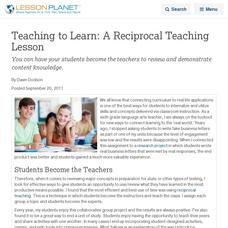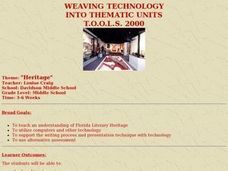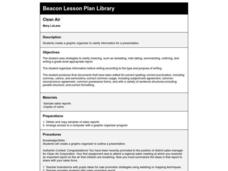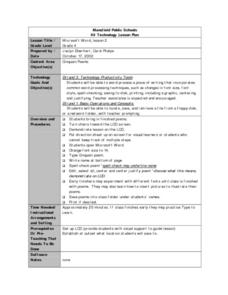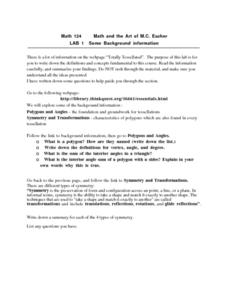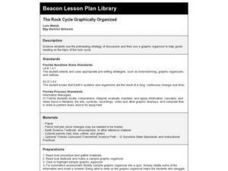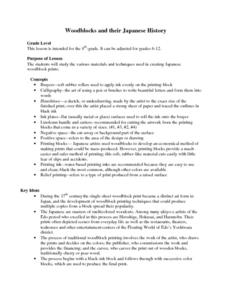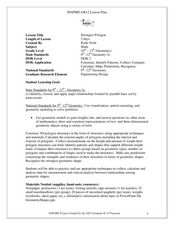Curated OER
Ways to Start the Year Off Right
Here are some simple ways to get your year off to a great start.
Curated OER
Teaching to Learn: A Reciprocal Teaching Lesson
You can have your students become the teachers to review and demonstrate content knowledge.
Curated OER
Heritage
Young scholars examine Florida literary heritage. They use multimedia learning activities to focus on Florida heritage and the literature of Florida. Students investigate books and special web sites on Florida cities and Florida...
Curated OER
Clean Air
High schoolers read sales promotion reports and create a sales promotion summary using information from the report. They develop a graphic organizer to outline their information for a presentation. There is an assessment checklist...
Curated OER
ReQuest and Motor Imaging with My Side of the Mountain
Fifth graders read "My Side of the Mountain." They create a pantomime using vocabulary words from the story. Students create three questions about the reading. They discuss the passage they read and act out words to help them better...
Curated OER
Cooking Terms - Level II
Pupils complete cooking terms with partners at their tables with the help of a foods classroom text.
Curated OER
Cinquain Poems
Fourth graders investigate the concept of composing a Cinquain poems. They copy a poem from a slide presentation given by the teacher. Students experiment changing the font in the poem. They also receive information about the format used...
Curated OER
Stress Reduction: Visual Imagery
Students use visual imagery in dealing with a stressful situation. They practice the visual imagery in class and at home. They record their reflections in a journal.
Curated OER
Vocabulary Charts
Students create their own vocabulary charts. They divide into groups and view an example of a vocabulary chart imbedded in this plan. Then, they create their own chart which is based on a particular subject area.
Curated OER
Math Lab
In this polygons and angles worksheet, 10th graders complete 5 different questions related to polygons and angles, in addition to symmetry and transformations. First, they define polygon and how they are named. Then, students define...
Curated OER
Speaking Parametrically
Learners solve equations by taking the derivative. In this calculus lesson, students solve parametric equations implicitly. They use the TI-calculator to graph their equations.
Curated OER
Grammar Football
Students explore the ruloes for the correct usage of grammar. The game of football is played by classroom teams to acquire points each time an error is corrected by a member of the team.
Curated OER
Hunting for galaxies in the Hubble Deep Field
Learners examine Hubble Deep Field images. In this galaxy classification lesson, students research galaxy classification. Learners view and classify Hubble Deep field images of galaxies.
Curated OER
What Pie?
Students practice making and interpreting pie graphs so they are better able to decide if a pie chart is the appropriate form of display. Students examine included overheads of different pie charts, and directions on how to make pie...
Curated OER
The Rock Cycle Graphically Organized
Fourth graders use the prereading strategy of discussion and then use a graphic organizer to help guide reading on the topic of the rock cycle. They use a worksheet imbedded in this plan to guide thier inquiry.
Curated OER
Why Are Volcanoes Dangerous?
Students investigate the causes and characteristics of volcanic eruptions including pyroclastic eruptions. They study the effects of natural disasters.
Curated OER
"Journalism in Tennessee"
High schoolers listen to headline from National Enquirer or other tabloid, listen to story "Journalism in Tennessee," compare and contrast connections between Twain's idea of journalism with present day journalism, define vocabulary, and...
Curated OER
Pythagorean Theorem
Students explore how the Pythagorean Theorem works and how to apply it.
Curated OER
Color Enhanced Maps
Learners download or create maps with numerical weather data. They add isolines and color to create regions on their maps. They explore the visual properties of color palettes and create a visualization applying their knowledge.
Curated OER
Cells are 3-D!
Students design three dimensional models of plant and animal cells. They identify the cells parts, and compare animal and plant cells.
Curated OER
Woodblocks And Their Japanese History
Students create replicas of Japanese woodblock prints using their own art as the basis for design in this excellent cross-curricular Art project applicable to Language Arts, Social Studies, or Art classrooms.
Curated OER
Pythagorean Theorem
Learners are introduced to the Pythagorean theorem. They use three different activities that give students the opportuntiy to observe triangles, and use the Pythagorean theorem and practice different ways of determining areas of...
Curated OER
Fractals and the Chaos Game
High schoolers explore the concept of fractals. In this fractals lesson, students play the "Chaos Game" via an applet. High schoolers place dots on the screen to recognize that they have created Sierpinski's Triangle.
Curated OER
Strongest Polygon
Students define and identify shapes by name. In this geometry lesson, students construct, identify and compare polygons based on the number of sides. They classify each shape based on their angle sum theorem.



